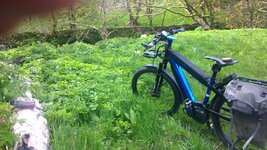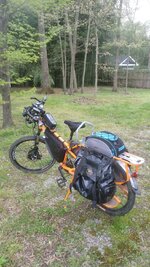Shaun, I'm also in awe of your talent for building these bikes. I wish we lived in the same city. Living right beside Vancouver I'm so tempted to buy a GMAC kit from Grin and build a nice cargo hauler, but I'm worried I'll mess it up because I've never been that handy. I do minor maintenance on my bikes, but anything significant, I hire someone.
Captain, if I may...
I'm 100% self taught. My day job is computer work so my only experience with tools was building computer towers and screwing monitor mounts on basically.
Converting a bike of your choice using Grin supplied parts is actually quite easy.
The hardest parts are:
-Choosing the right donor bike for the project first (trial and error taught me well, now I help others in their decision making)
-Bottom Bracket swap for a torque sensing PAS
-Fighting your OCD when zip tying the wires externally to the frame.
Grin sells the motor of your choice installed in a rim matching the bike you are converting for the same cost/lower cost then having your LBS do it for you or heaven forbid trying to do it yourself.
The first time I attempted to do a bottom bracket swap I realized I didn't have all the proper tools I needed so I had my LBS do that install for a reasonable fee. I have since bought the $50 worth of tools you need from Amazon to do it myself.
Bottom bracket aside, the only tools you need are your standard Allen keys and a socket set.
-Grin's motors connect to their controllers
-Grin's controllers directly connect to their CA3 bike computers
-Accessories like brake handles and the PAS you choose (rotational or torque sensing) all just plug and play.
If you source your batteries from Grin then they too are just plug and play with Anderson 45 connectors.
As you can understand now, with a LBS to do your bottom bracket and everything ordered from Grin leaves you with just needing the same basic tools you use on an acoustic bike already.
With a bottom bracket done I can convert a bike to electric with Grin parts in just a few hours. That includes setting up the controller with the laptop (10 minutes) and CA3 (10 minutes).
For me, the only parts I do not order from Grin is batteries. I source my batteries from EM3EV out of china to get higher Wh capacity choices and price her Wh. This lead me to learning about proper wiring techniques and all I can say is 'Self soldering butt connectors are a life saver' - lol.
Here is my next project I'm just starting. I previously converted this donor bike using a Bionx D500 setup. I added pannier bags and was carrying 4 additional (2 per side) of the Bionx 11.6Ah 48V batteries. I had 10-12 great rides on it, rotating through the 5 batteries every 60-90 minutes, reaching 163kms as my longest ride.
Sadly, a $0.02 screw and a rough bump caused the loaded down pannier to break free and break 6 spokes in my rear wheel. Thankfully a gent near the path was happy to give me a ride to my car to then collect my bike and return home. Lessons learned all the way around.
Now going with Grin parts, I have a pre-built 9C RH212 motor in a 700C rim, phaserunner controller, CA3 computer, ebrake adapter, throttle, multifunction controller and torque sensing bottom bracket PAS.
I will test fit the rear wheel and then tackle the bottom bracket/chain ring rebuild. That's the only hard part. After that I will just install the parts, solder up the battery mount connections to the controller and zip tie everything.
I have a new trunk rack for the rear, this time it clamps to the A frame of the rear wheel and seat post. No more $0.02 screws. Going with a compatible top trunk and pannier bags, I will carry only 1 battery per side this time.
I already own from another project 3 High Amp (55 Amp max draw for a 2WD setup) downtube batteries from EM3EV with 14.3Ah (1) and 12.3Ah (2) that will provide me 39Ah of capacity at 52V. I estimate with this better setup then the Bionx and slightly larger Ah batteries I will have around a 120-140km range with my fitness level.
If I was buying new batteries from EM3EV, they have 17Ah downtube batteries of the same case size (34 Amp max draw, fine for a single motor setup) which would be a whopping 51Ah capacity over 3 batteries.
Captain - 51Ah is 2570Wh....so at your 2-3Wh per Km riding level you could go...oh....1,000kms?



I suspect a fit rider like you Captain on my 'medium heavy' bike build would be around 10Wh/Km and could reach 250km range with only 3 batteries. My cargo bike build does use about 30% of the battery capacity to offset the weight of the bike (and the batteries themselves) over all for sure...the 'loss' of going heavier with all batteries versus trying to make a solar setup work.
As you can relate, building a bike with a 150KM range like I am - that weighs 50lbs without the batteries/rear trunk rack and can be carried by my car's hitch mount bike carrier, is the perfect mid-range bike for me to have out riding with my most fit of friends who do 100-150kms acoustic (proud of them) and then if I want to go further, I switch to the cargo bike...
...and the utility trailer I need to transport it.


Back to the bike build - noting you had a Bionx in your past my friend you can relate to how most of the conversion of a donor bike is quite simple with basic tools and skills. Bionx had the torque sensing PAS built into the motor as you know so that is where I had to learn about bottom bracket torque sensing PAS, but a LBS will swap yours for you (if you ever did a project like this) for just a small service fee I have found...the rest you could do yourself if you wanted to.
...and final note - while I have learned a ton about amazing OEM bikes here on EBR...even test rode a bunch of them to see...it has taught me I really do love choosing my donor bike of choice, RWD or 2WD setup of choice and battery/batteries to meet my riding needs and fitness level.
Here's a pic of the bike I'm building with Grin parts when it was a Bionx setup. 4 extra batteries tucked in those panniers and 4 extra bottles of fluids in the top:
My next thread I will post here will be the build of this same bike but with the Grin supplied parts and EM3EV batteries.
Captain, if you ever want to pull the trigger on a Grin build - I'm just a PM away.
Thanks for reading
Shaun











